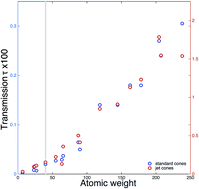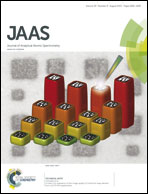Instrumental isotope fractionation in multiple-collector icp-ms
Abstract
This work addresses the issue of how isotope mass biases in modern Multiple-Collector Inductively Coupled Plasma Mass Spectrometers (MC-ICP-MS) changes with increasing efficiency of ion transfer through the instrument, which is known as transmission (τ). For any element, when all the ions introduced into the source are accounted for at the collector, the instrumental mass bias must vanish. With the latest cone designs, such as Thermo Finnigan jet cones, transmissions in excess of 2 percent are now obtained for heavy elements and coincide with smaller values of instrumental isotope fractionation factors. Transmission of ions across the entire mass range has been measured on a Thermo Neptune Plus equipped with standard and jet cones. It was found that transmission τ of elements above mass 40 increases linearly with the atomic weight. Comparing this relationship with the well-established linear dependence of ion energy with atomic mass indicates that high transmission is intimately related to the thermodynamic reversibility of the gas flow in the interface. Instrumental isotope fractionation obeys an exponential law with β as a coefficient. Instrumental isotopic fractionation is due to the transverse spread of the beam inherited from Ar thermal movements at the high temperatures of the plasma. It was found that, for τ > 0.002, the exponential law coefficient β ≈ −0.24 ± 0.02 ln τ in contrast to β ≈ 2 at lower transmission. The exponential mass fractionation coefficient can be approximated by the following law: β = β0 (1 − τγ).


 Please wait while we load your content...
Please wait while we load your content...